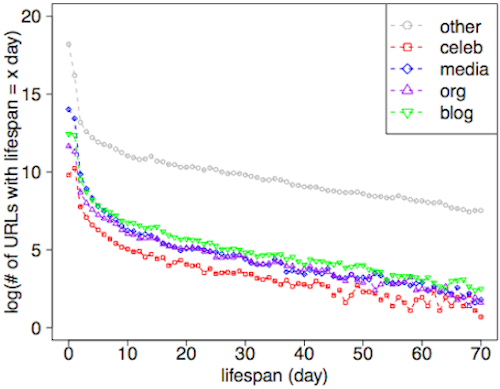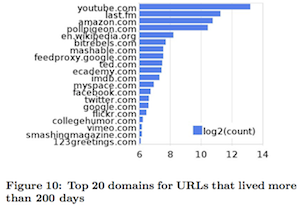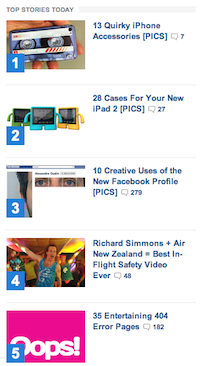
Who says what to whom on Twitter? That’s the subject — and the title — of a just-released report from Yahoo Research. (You can read the abstract, and download the report’s pdf, here.) Four scientists — Shaomei Wu, Jake Hofman, Winter Mason, and Duncan Watts — studied the production, flow, and consumption of information on Twitter. Leveraging Twitter lists to classify users as, broadly, “elite” or “ordinary,” they found a dramatic concentration of attention: 50 percent of tweets consumed are generated by just 20,000 elite users. Or, as the authors note later in the study: “Roughly 0.05% of the population accounts for almost half of all attention.”
That’s a big finding, if not a terribly surprising one: We know anecdotally how discrepant the producer-to-consumer ratio is on Twitter, and know as well that, despite the fragmented attention of the web, online consumption to some extent mimics the concentration trends of traditional media. (Same deal for another of the study’s big findings: that, on Twitter, there’s “significant homophily within categories,” meaning that “celebrities listen to celebrities, while bloggers listen to bloggers etc.”)
But there are two other key takeaways in the study worth highlighting, particularly for news organizations trying to figure out how their content meshes with the web’s social layer. First, there’s the concentration-of-distribution idea: the way users discover, and then consume, media content on Twitter. Second, there’s the longevity idea: the lifespan of that content as it enters our consciousness and then, often almost instantly, fades away.
The classic assumption about distribution — the one, the study notes, “supposed by early theories of mass communication” — holds that information flows from news organizations directly to consumers. That’s a (generally) accurate model for a print-and-broadcast-driven world, where consumers and news brands operate in generally direct relationships with each other. (You read the newspaper, you watch the evening news, etc.) And the assumption of an A-to-B flow still dominates our assumptions about news consumption and user experience, in everything from the logic of apps to the logic of paywalls.
The Twitter study, though, suggests the emerging dominance of what it calls “two-step communication”: essentially, news consumption that’s driven by social networks. In this type of communication, there’s an A-to-B-to-C flow of info, with intermediaries filtering information before it reaches (and, actually, in order to reach) the consumer. “We find considerable support for the two-step flow of information,” the study notes. “Almost half the information that originates from the media passes to the masses indirectly via a diffuse intermediate layer of opinion leaders, who although classified as ordinary users, are more connected and more exposed to the media than their followers.” As Business Insider sums it up: “Twitter is the Evening News broadcast: full of stories reported elsewhere, brought to your attention by a personality you trust.”
And then there’s the broad makeup of the social layer. “In total,” the study notes, “the population of intermediaries is smaller than that of the users who rely on them, but still surprisingly large, roughly 500K, the vast majority of which (96%) are classified ordinary users, not elites.” And at least some of those intermediaries, the study notes, also receive the majority of their media content indirectly — “just like other ordinary users.” So the social layer is truly a social layer: spread out across the Twittersphere, widely distributed. And in some sense, the study notes, that finding actually has a back-to-the-future sensibility to it: “These results,” the authors write, “are all broadly consistent with the original conception of the two-step flow, advanced over 50 years ago, which emphasized that opinion leaders were ‘distributed in all occupational groups, and on every social and economic level.'”
 Another component of the study is an analysis of what accounts for link longevity on Twitter. “We also find that different types of content exhibit very different lifespans,” the study notes (lifespan, in this context, being “the time lag between the first and last appearance of a given URL on Twitter”). “In particular, media-originated URLs are disproportionately represented among short-lived URLs” (which makes sense — “the news,” after all, being “what’s new”). Similarly sensibly, “the longest-lived URLs are dominated by content such as videos and music, which are continually being rediscovered by Twitter users and appear to persist indefinitely.”
Another component of the study is an analysis of what accounts for link longevity on Twitter. “We also find that different types of content exhibit very different lifespans,” the study notes (lifespan, in this context, being “the time lag between the first and last appearance of a given URL on Twitter”). “In particular, media-originated URLs are disproportionately represented among short-lived URLs” (which makes sense — “the news,” after all, being “what’s new”). Similarly sensibly, “the longest-lived URLs are dominated by content such as videos and music, which are continually being rediscovered by Twitter users and appear to persist indefinitely.”
That’s interesting in itself from a long-tail perspective of economic value: Tweets that accrue attention over time can end up being more valuable, attention-economy-wise, than tweets that explode and then, instantly, fade.
But there’s another interesting note here. Check out the list of longest-lifespanned sites — specifically, “the top 20 domains for URLs that lived more than 200 days” — and you’ll see, among the expected video-heavy, evergreen-y sites (YouTube, last.fm, Ted, Flickr, etc.), one relatively traditional media company: Mashable. Which is number 7 out of 20.
 Part of that can be attributed to the fact that, for a media company, Mashable produces a ton of content every day — so, as a pure numbers game, the odds of producing some long-life-span stuff are in Mashable’s favor compared to less output-focused outlets. Then again, The New York Times and CNN, for example — whose Twitter feeds the study identifies as the most-followed among media outlets — didn’t make the Longevity 20. So there’s more to this than numbers alone. In a post today called “How Mashable won,” Nicholas Carlson speculates that Mashable’s success — it long ago passed the mighty TechCrunch in terms of overall traffic — has to do with Mashable’s adherence to “two very old-fashioned media rules for success”: first, “Know your audience,” and, second, “Don’t be afraid to be service-y.”
Part of that can be attributed to the fact that, for a media company, Mashable produces a ton of content every day — so, as a pure numbers game, the odds of producing some long-life-span stuff are in Mashable’s favor compared to less output-focused outlets. Then again, The New York Times and CNN, for example — whose Twitter feeds the study identifies as the most-followed among media outlets — didn’t make the Longevity 20. So there’s more to this than numbers alone. In a post today called “How Mashable won,” Nicholas Carlson speculates that Mashable’s success — it long ago passed the mighty TechCrunch in terms of overall traffic — has to do with Mashable’s adherence to “two very old-fashioned media rules for success”: first, “Know your audience,” and, second, “Don’t be afraid to be service-y.”
I’d see that, and raise. Mashable content, like the overall content of lots of media outlets, is a mix of breaking-news info, explainers, more think-y pieces, and, yes, “service-y” posts. But check out today’s “top stories” on Mashable‘s homepage: Of the top 5, four of them are…listicles. Three of them involve pictures. One of them involves Richard Simmons. While that one’s probably an outlier — let’s call it the Simmons Exception — it’s telling, even given the stories’ nowhere-near-scientific sample size, that 80 percent of the day’s top stories are lists. Which tend to be, in general, not just service-y, but context-focused and, often, evergreen. They provide, even the silly ones, frameworks for understanding a topic or event. Yes, Mashable’s listicles involve content that’s implicitly entertaining (“35 Entertaining 404 Error Pages”), but they also, in their very structure, suggest a kind of timelessness. That could be one small part of Mashable’s shelf-life success.